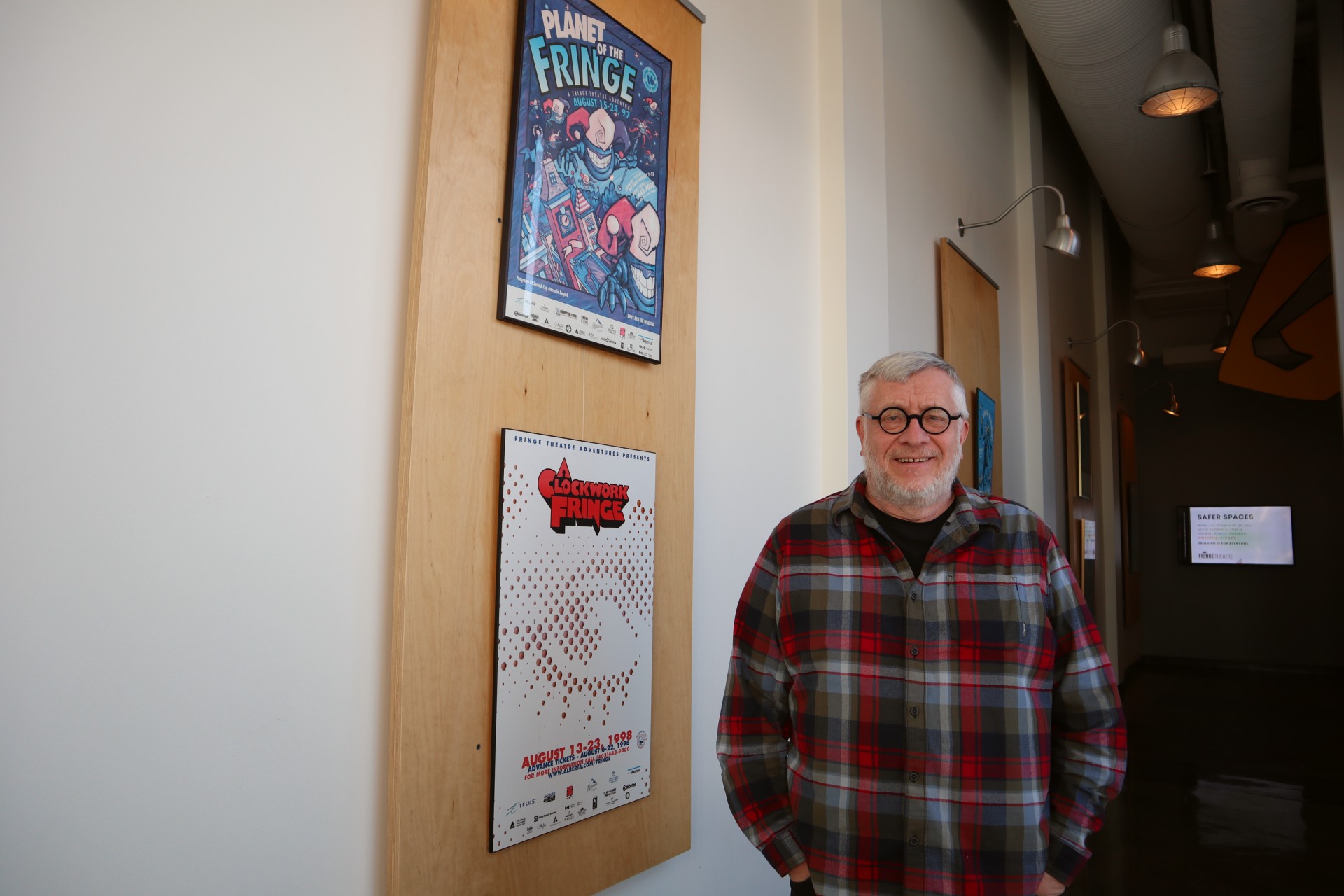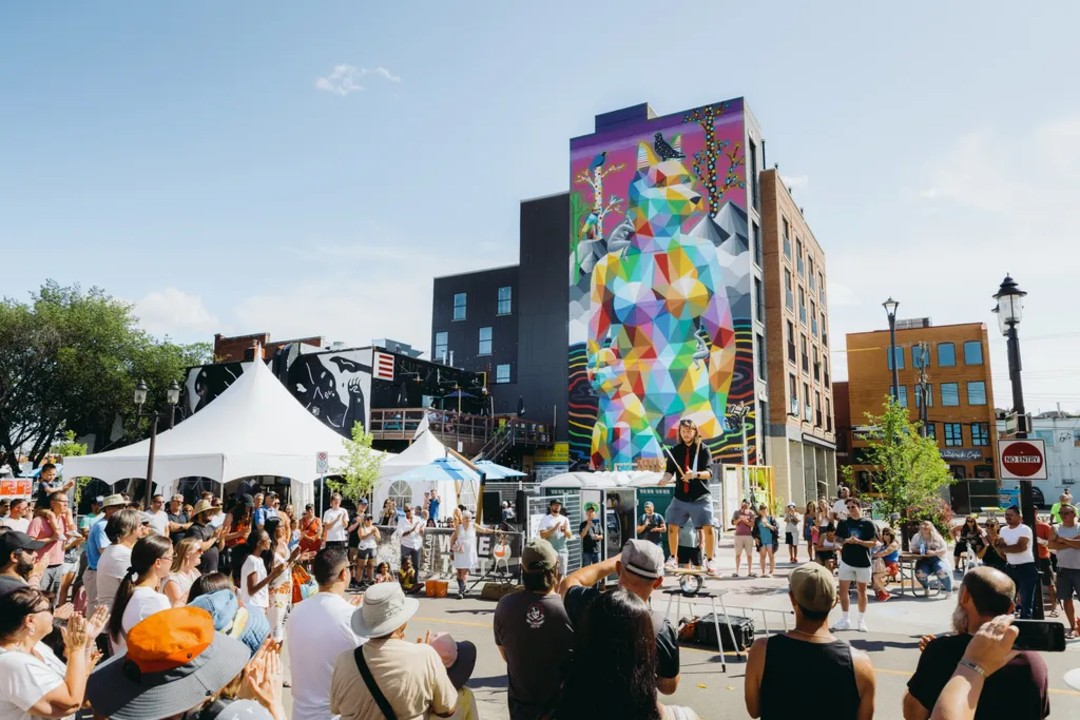Gerald Osborn, the Edmonton International Fringe Theatre Festival's first official historian, told Taproot that he always lies that he was at the first festival in 1982.
"But I wasn't. I didn't know anything about it," Osborn said. "But then in '83, a friend said, 'Want to go to the Fringe?' And next thing you know, you're sitting in some coffee shop at midnight with a pillar in front of your face and you're watching really strange things, but it was really fun."
Osborn is the Fringe's longest-serving employee and took on the additional role of official historian in January after years of it being an unofficial title. The role is still new, so Osborn said he isn't totally sure what it will entail at the 2025 festival. However, the Fringe is already planning for its 50th anniversary in 2031.
Osborn remembers when artists would camp outside for days in December to secure a spot in the festival; the year the festival started allowing unsanctioned, unconventional venues; and the time police gave warnings about a play with a title involving a crude word for a woman's body part. Unlike many historians, he's been around Fringe since (nearly) the beginning and has firsthand memories of the weird, lovely, and infamous moments that make up the history of North America's largest and oldest fringe theatre festival.
Brian Paisley, then artistic director of Chinook Theatre, started the Edmonton Fringe in 1982, inspired by the Edinburgh Fringe Festival in Scotland, which began in 1947 as an unofficial offshoot "on the fringe of" the stodgy Edinburgh International Festival. With a $50,000 grant from Edmonton Summerfest, the first Fringe had five venues with four or five plays each.
Osborn produced his first Fringe show in 1986. He then started working in the Fringe office in 1989, a job he took, he says, so that he would have access to a real bathroom and not a Port-a-Potty on the Fringe grounds during the festival.
The Strathcona area was a bit dodgy when the Fringe started, Osborn said. "It was a lot of abandoned spaces and things like that, so it was perfect for doing a festival because you had, (for example), this storefront that you can do shows in," he said. "I walk past buildings sometimes, and I stop and I think, 'Did I see a Fringe show here?'"
In a way, Fringe history is Edmonton theatre history, as many artists and companies that saw local and national success did some of their earliest work at the Fringe, he said.
"The summer was really quiet a lot of times for performers, so it was a chance for them to do things that they would normally not be able to do," Osborn said. "And now it's part of the landscape."

Fringe's first official historian, Gerald Osborn, has been Fringing for nearly five decades. (Stephanie Swensrude)
Teatro Live! began as Teatro La Quindicina, founded by Stewart Lemoine at the first Fringe in 1982. The company had a certain style, Osborn said, and established theatre companies took note and started asking Lemoine to direct shows. "I don't know if they want us to claim it, but it's a success story of the festival," Osborn said.
Three Dead Trolls in a Baggie, the irreverent musical group known across Canada for tunes like The Toronto Song and The War of 1812, started in Edmonton and did an annual Fringe show for which audiences would line up for hours.
More recently, Bear Grease started at the 2021 Fringe and has now toured across North America and had a run at the Citadel Theatre; Makram Ayache's play The Green Line debuted at the 2019 festival and was shortlisted for the 2024 Governor General's Literary Awards; and Rat Academy won three Sterling Awards in 2024 and is wrapping up a western Canada tour.
Though Edmonton's Fringe was inspired by Edinburgh's, it quickly became its own unique festival and ended up as the template for fringe festivals across North America, Osborn said.
Edmonton's Fringe came up with the "bring-your-own-venue" system, or BYOV (that term was coined in 1992 — Osborn said he has two friends who each claim it was their idea). It started as a way to stage productions in an unconventional venue that worked thematically. One year a company did A Midsummer Night's Dream on ice at the Granite Curling Club. Another year a company used a garage as its venue and the actor peeled onto the "stage" in a car. Now, BYOVs are mainly just venues for those artists who didn't get drawn in the lottery, Osborn said.
The lottery system came a few years after Judy Lawrence, then festival director, restricted the number of spots in sanctioned venues for local acts to 50 for the 1993 festival. Applications are online now, but back then, Fringe artists had to line up with their application at the Fringe office. Thanks to the quota that year, applicants started lining up at 9pm on a Sunday night in the middle of December to have their application processed at 9am on Monday morning.
"I believe that we let them in just so they wouldn't have to be standing outside all that time," Osborn said.
The next year, applicants started lining up on Saturday night. The year after, an applicant paid a man to camp in a tent outside the office starting on Wednesday night. "We couldn't talk him into leaving because he was being paid and he had this job to do," Osborn recalls. "Maybe I'm exaggerating, maybe it wasn't Wednesday, but it sounds better if it's Wednesday." That jumpstarted the line — artists around the city called one another to alert them that the Fringe line had started. He remembers some sort of scuffle or threat among the artists camped out to earn their spot. "At that point, David Cheoros was running things and he just took everybody's name, sent everybody home, and from that moment on, we just went lottery the whole time," Osborn said. "Because to allow somebody to have that much power, in a way, it's crazy."

The Fringe's outdoor performances are free to attend. (City of Edmonton)
Only about 75 of the more than 200 Fringe shows are in official Fringe venues each year. The festival draws names for those spots and the artists receive about $10,000 of in-kind support, including the cost of the venue rental, lighting and sound equipment, and two venue technicians. All other shows are in BYOVs.
A key value of the Fringe is that it's not juried. Osborn himself, even though his plays have been produced at the festival more than two dozen times, had to enter the lottery just like a first-time theatre producer would have to. He didn't win a spot this year, by the way — look out for his show at the Holy Trinity Anglican Church BYOV this summer.
The festival also makes a point to not censor its artists, Osborn said, which is how police came to give warnings about the aforementioned play with a crude word in its title. It was the Fringe of 1994, and Osborn remembers that the play was initially called Good Girl, Bad Girl. The group changed its name one day after changes to the program were typically allowed, but former director Lawrence allowed the change to align with the anti-censorship value. "Judy was brave, because you didn't even know the legality of something like that, putting up certain words," Osborn said. "Nowadays, I don't think anybody even cares, really, but putting the poster up was sort of an act of — not defiance, but you know what I mean?"
When asked for a crazy Fringe anecdote, Osborn recalls a group of artists from Russia that produced Animal Farm in the early 1990s. Towards the end of the festival, it wasn't clear whether the artists would be able to return home, Osborn said.
"I just remember — I don't know if this actually happened, or maybe it's in the little Fringe in my head — but I remember walking across the site one evening and they were singing mournful Russian folk songs in the beer tent, very haunting," Osborn said.
Until he gets busy planning for the festival's 50th anniversary, he's working on a more robust historical timeline for the Fringe's website and filling in the gaps in his own memory by contacting Fringers from the past five decades.
"Somebody was inquiring because there used to be a street dance for Fringe before the festival, and the big famous one had k.d. lang performing. I was able to contact Brian Paisley, who created the whole Fringe. I think he lives in Mexico now — I Facebook him, ask him a few questions," Osborn said. "It's just so handy to have these people that I haven't alienated myself from them, so they tell me the truth."
